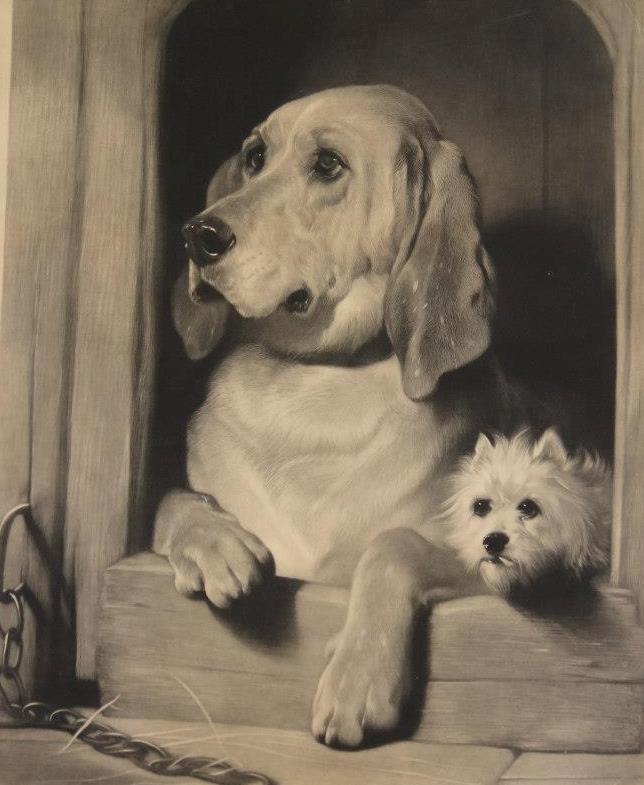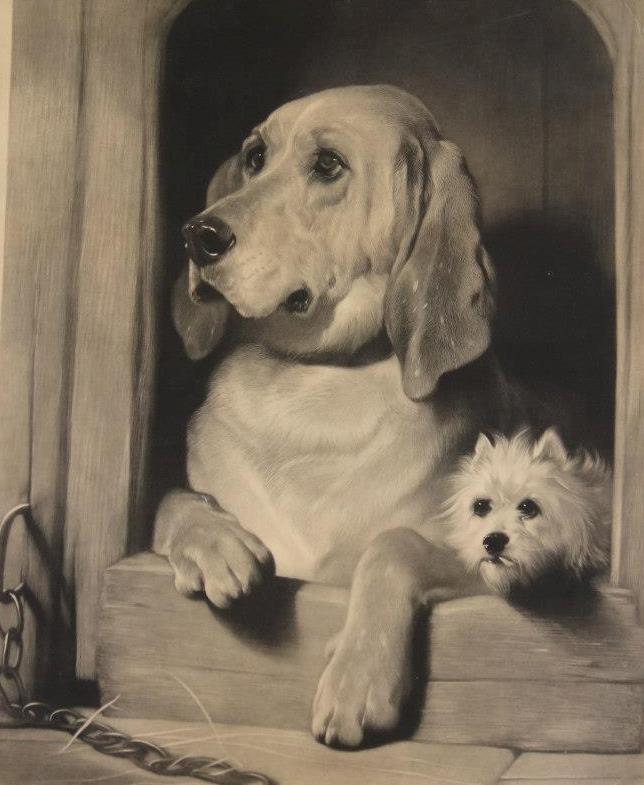A troubled artist: Sir Edwin Landseer
The RCVS headquarters tidy-up has revealed another gem, and led us to discover the fascinating story of a troubled man. Eight large prints of paintings by Sir Edwin Henry Landseer (1802-1873), depicting animals and bucolic scenes, have been discovered.
Landseer (1802-1873), an English painter, was renowned for his paintings of horses and dogs. Included in his artistic achievements are the lion sculptures in Trafalgar Square. His dog paintings of the 1830’s are by far his most popular work, ‘Dignity and Impudence’ (1839) being the most famous of all.
The two dogs in the life sized ‘portrait’ belonged to Jacob Bell, a chemist, who commissioned the work. The bloodhound is called Grafton and the West Highland terrier is named Scratch. Landseer cleverly parodies the Dutch portraiture style, where the subject is framed by either a window or a door, with a hand hanging over the edge. According to the Tate’s summary of Landseer’s painting, Grafton was quite the bohemian and was a visitor at several artists’ studios in London but Scratch was Bell’s favourite of the two dogs. Apparently, Bell made a bet with the owner of a poodle that his West Highland terrier was the better looking of the two. Landseer was to be the judge, he took one look at Scratch and announced, without any prompting, ‘Oh what a beauty!’
Bell and Landseer’s lifelong friendship was founded on a mutual love of animals. Eventually Landseer came to rely on Bell as a business advisor, being ill equipped to deal with every day business matters. Along with Landseer’s brother James, Bell oversaw the commission and sale of his portraits, securing the very best prices. He took on rather more duties than a normal business manager might, as he was heavily involved in the rebuilding of Landseer’s home and helped him to purchase land.
Landseer was the youngest son of an engraver and initially developed his talents with his father. He was later sent, along with his two brothers, to study under Benjamin Robert Haydon, the historical painter, in 1815. It was Haydon who encouraged Landseer to study animal anatomy. His early paintings benefit from his excellent anatomical knowledge and portray a variety of moral messages which contributed to his popularity with his Victorian audience. His later work was marred by his sentimentality and the humanization of his animal subjects.
Landseer had social as well as professional success; his friends included Dickens and Thackeray. He moved freely in aristocratic circles and enjoyed royal patronage in the 1840s. A favourite painter of Queen Victoria’s, she described Landseer as being ‘very good looking although rather short’. Landseer visited Balmoral in 1850 to paint a portrait of the royal family. The painting was never finished, and the failure of his first royal commission greatly contributed to his deteriorating mental health.
In 1840, Landseer suffered a severe mental breakdown, thought to be triggered by the Duchess of Bedford’s refusal of his marriage proposal (Incidentally, the Duchess was the originator of the very British concept of ‘afternoon tea’!). For the rest of Landseer’s life he was plagued by severe bouts of depression, exacerbated by his alcohol and drug use. His family had him declared insane in July 1872. Landseer died a year later on 1 October, 1873. The country mourned the loss greatly, shops and houses lowered their blinds, flags were hung at half mast and crowds lined the street to watch his funeral procession.
See our full collection of Edwin Landseer’s prints on our Facebook page.


